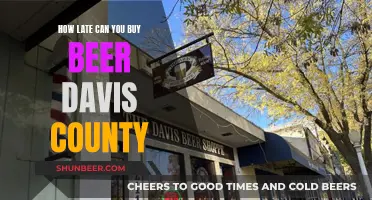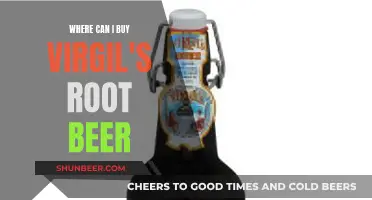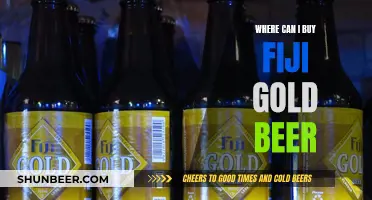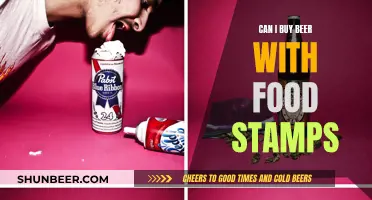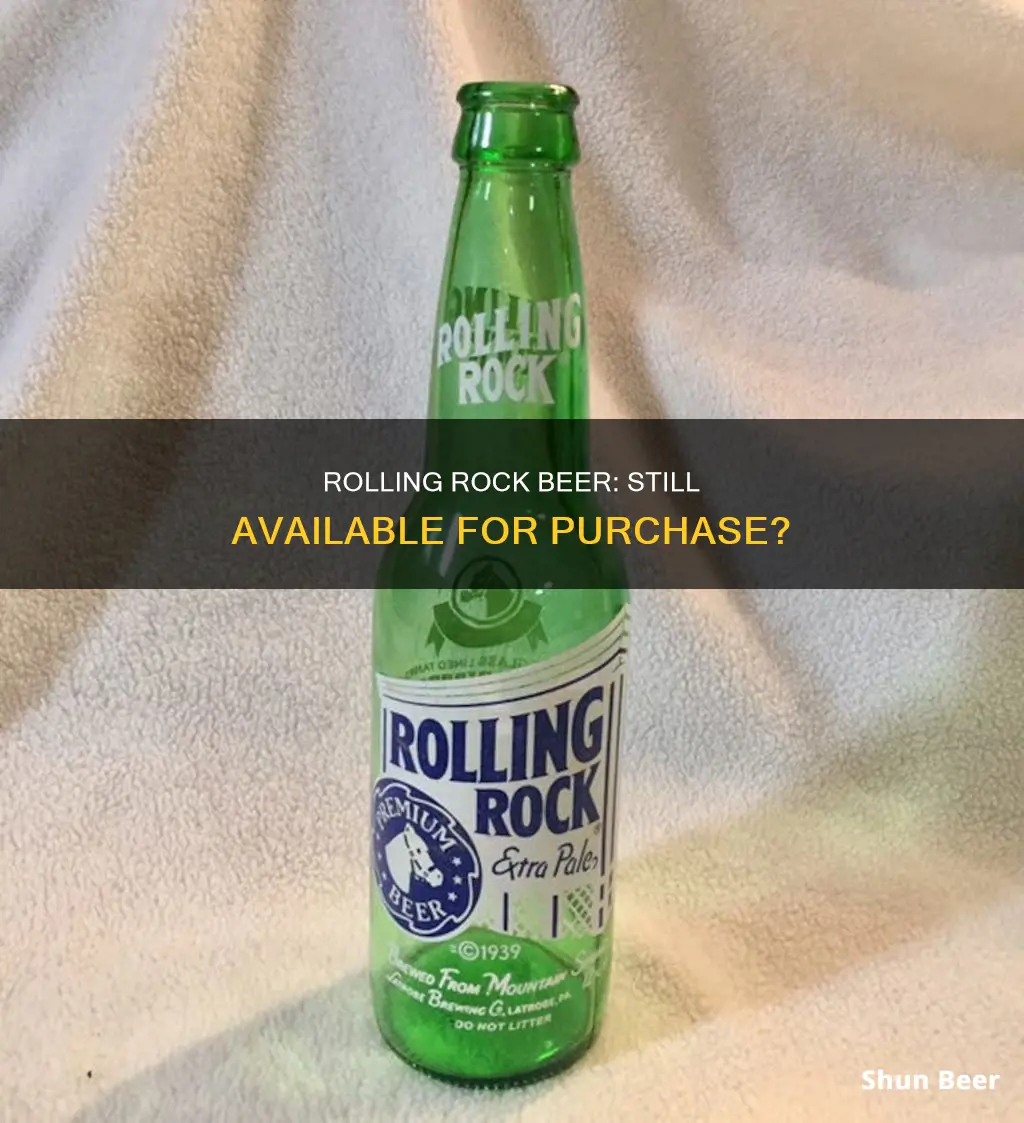
Rolling Rock is an American lager with 4.4% ABV, first launched in 1939. It was originally brewed in Latrobe, Pennsylvania, but the brand was sold to Anheuser-Busch in 2006, and brewing operations were moved to New Jersey. The beer is known for its distinct green packaging and the image of a pony on every bottle or can. While Rolling Rock is still available for purchase in the United States, it appears to be more difficult to find in other countries, such as the UK.
| Characteristics | Values |
|---|---|
| ABV | 4.4% to 4.5% |
| Calories | ~100 |
| Manufacturer | Anheuser-Busch InBev |
| Manufacturer Location | St. Louis, Missouri |
| Original Manufacturer | Latrobe Brewing Company |
| Original Manufacturer Location | Latrobe, Pennsylvania |
| Year Introduced | 1939 |
| Type | American Lager |
| Colour | Green |
| Logo | Pony |
| Available in | Bottles, Cans |
What You'll Learn

Rolling Rock's availability in the UK
Rolling Rock is an American lager that was launched in 1939 by the Latrobe Brewing Company in Western Pennsylvania. It was brewed in Latrobe until 2006 when the brand was sold to Anheuser-Busch, which transferred brewing operations to New Jersey.
As for its availability in the UK, it seems that Rolling Rock is no longer sold by major retailers in the country. One source from 2011 mentions that Asda sold Rolling Rock, but this information is outdated and may no longer be accurate.
Some online retailers, such as Amazon UK, offer Rolling Rock merchandise, including T-shirts and neon signs. However, there is no indication that the beer itself is available for purchase on Amazon UK or other online stores that deliver to the UK.
One option for those seeking to buy Rolling Rock in the UK may be to contact the corporate headquarters and inquire about the possibility of having it shipped from the United States, although this may incur additional costs.
Best Places to Buy Beer Steins: A Comprehensive Guide
You may want to see also

The history of Rolling Rock
Rolling Rock is an American lager with 4.4% ABV. It was first launched in 1939 by the Latrobe Brewing Company, based in Latrobe, Pennsylvania. The company was founded in 1893 and was run as an extension of the Pittsburgh Brewing Company until 1920 when Prohibition halted operations.
During Prohibition, four brothers from the Tito family—Frank, Robert, Ralph, and Anthony—bought the Latrobe facility in anticipation of the end of Prohibition. Their gamble paid off, and in 1933, they resumed brewing. For the next six years, they brewed Latrobe Old German and Latrobe Pilsner varieties. In 1939, they perfected the Rolling Rock recipe and released it for sale.
Rolling Rock soon became a popular national product, thanks to aggressive marketing. Its distinct green packaging and pony logo became iconic. In 1974, Rolling Rock sales peaked at 720,000 barrels. However, by the 1980s, its popularity began to dip due to a lack of aggressive marketing compared to competitors. In 1985, the Tito family sold the Latrobe Brewing Company to the Sundor Group.
Over the next two decades, Rolling Rock changed hands several times. In 2006, it was sold to Anheuser-Busch, which transferred brewing operations to New Jersey. This move led to a nationwide boycott by union leaders in Westmoreland County. In 2008, ownership of Rolling Rock returned to InBev (now known as Anheuser-Busch InBev), which had also acquired Anheuser-Busch. In 2015, Anheuser-Busch stopped brewing bottled Rolling Rock in glass-lined tanks, opting to use the traditional process only for canned beer.
The number "33" is prominently featured on Rolling Rock bottles, and various theories have emerged to explain its significance. One popular belief is that it marks the repeal of Prohibition in 1933. James L. Tito, former CEO of Latrobe Brewing, suggested that "33" represents the 33 words in the original pledge of quality printed on every bottle.
Buying Beer and Liquor: Cleveland, GA's Rules
You may want to see also

The significance of the number 33 on Rolling Rock bottles
The number 33 is printed prominently on all bottles of Rolling Rock beer, and there has been much speculation about its meaning. One theory is that it refers to the year 1933, the founding year of the Pittsburgh Steelers, who hold their annual training camp in Latrobe, Pennsylvania, where Rolling Rock was originally brewed. Another theory is that 33 degrees Fahrenheit is the ideal temperature to store beer.
Other speculations include a connection to the 33 degrees of Scottish Rite Freemasonry, or that 33 batches of beer were test-brewed before the final formula for Rolling Rock was decided upon. There is also a belief that there were 33 steps from the brewmaster's office to the brewing floor in the original Latrobe brewery.
The words "Rolling Rock" appear three times on the bottle, totalling 33 letters, which may be another reason for the number's prominence. James L. Tito, former CEO of Latrobe Brewing, offered his opinion that the number 33 represents the 33 words in the original pledge of quality, which is printed on every bottle. This theory is supported by the fact that the company has carefully maintained this word count as the wording on the labels has changed over the years.
Despite these various theories, Tito admits that there is no definitive proof of the true origin of the number 33 on Rolling Rock bottles, and its significance remains a mystery.
Buying Beer on Sundays in Pawleys Island, SC: What's Allowed?
You may want to see also

Rolling Rock's marketing and branding
The brand's bread-and-butter is its distinctive green bottle and pony logo, which has become synonymous with the beer. This iconic packaging was leveraged by Labatt when they bought the brand in 1987, bringing it back to national attention. Rolling Rock's marketing plays off its small-town vibe and classic taste, positioning it as a reliable, tried-and-true beer that has stood the test of time.
Their advertising campaigns are simple and relaxed, often featuring the green bottle as a focal point. This straightforward approach has been a constant, even as the brand changed hands multiple times. For example, in the 2000s, a fictitious character, Ron Stablehorn, was created as the Vice President of Marketing for viral marketing campaigns. These campaigns featured Stablehorn denouncing upcoming ads that were intentionally outrageous, such as an ape dancing suggestively with a woman, thus promoting the ads while appearing to apologise for them.
The number 33, which appears on all bottles, has also sparked intrigue and speculation among consumers, with various theories about its meaning, including a reference to the number of words in the original pledge of quality. This pledge, which has evolved slightly over the years, is still printed on every bottle, reinforcing the brand's commitment to quality and tradition.
The brand has also benefited from product placement in popular culture, including appearances in films like "The Deer Hunter" and "That's My Boy", and TV shows like "The Sopranos" and "Mare of Easttown".
Beer Availability at ASU Football Games
You may want to see also

Rolling Rock's current owner
Rolling Rock is currently owned by Anheuser-Busch InBev, a Belgian company based in Belgium. The brand was first launched in 1939 by the Latrobe Brewing Company, which owned and brewed Rolling Rock for nearly seventy years. In mid-2006, the Latrobe Brewing Company sold the Rolling Rock brand to Anheuser-Busch of St. Louis, Missouri, for $82 million. Anheuser-Busch then transferred brewing operations to New Jersey while continuing to label the beer with the name of Latrobe.
In July 2008, InBev reached a deal to acquire Anheuser-Busch, thereby returning ownership of Rolling Rock to InBev. In 2009, Anheuser-Busch InBev announced that it was considering selling the Rolling Rock brand. Since its acquisition by Anheuser-Busch InBev, fans of the beer have noticed a change in its taste. In 2015, the company stopped brewing bottled Rolling Rock in glass-lined tanks, instead reserving this traditional process for the canned beer.
The Latrobe Brewing Company, which originally owned Rolling Rock, was founded in 1893 and was located in Latrobe, Pennsylvania. The company was purchased during the time of Prohibition by four local brothers, Frank, Robert, Ralph, and Anthony Tito, who hoped that Prohibition would soon be repealed. In 1933, when Prohibition ended, the Tito brothers resumed brewing beer, and in 1939 they perfected the Rolling Rock recipe and sent it out for sale. By the 1970s, Rolling Rock had become a popular beer across North America. However, by the 1980s, Rolling Rock's popularity began to dip due to a lack of aggressive marketing compared to other major brewing companies. In 1985, the Tito family sold the Latrobe Brewing Company, and over the next 20 years, Rolling Rock changed hands several times before finding its current owners, Anheuser-Busch InBev.
Beer Delivery: DoorDash's Alcohol Ordering Service Explained
You may want to see also
Frequently asked questions
Yes, you can still buy Rolling Rock beer. It is an American lager that was first launched in 1939 and is currently owned by Anheuser-Busch InBev, based in Belgium.
In the United States, Rolling Rock beer can be purchased online through websites such as BeerMenus and GoToLiquorStore. It is also available at various pubs and stadiums in Ontario, Canada.
Rolling Rock is a 4.4% to 4.5% ABV lager.




